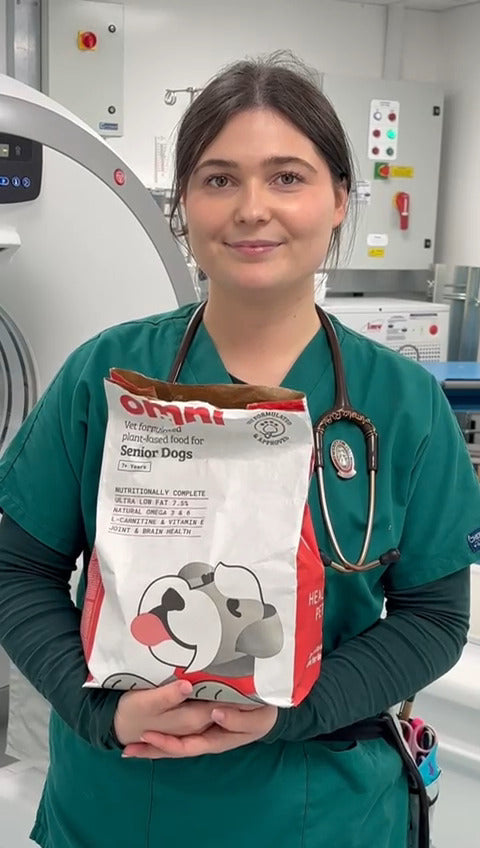Plant-based Dog Food - The Basics

Plant-Based Dog food
Plant-based food can be a great choice for your dog. Dogs are omnivores, and so like humans, can thrive without the need for animal products.Dogs have lived closely with us for thousands of years, and while early dogs will have had a primarily meat based diet, as they shared our food over the years, they adapted to become omnivores and developed the ability to digest plants (1). Dogs have many hallmarks of an omnivore such as producing salivary amylase (2), possession of high levels of glucokinase (3), and having Type D taste buds (4). Importantly, dogs have shown an excellent ability to digest plant proteins (5-11).
Dogs do have specific dietary needs - protein, carbohydrates, fats, minerals and vitamins, and all of these can be provided with a carefully designed plant based food.
- Protein - this is made up of small building blocks called amino acids, and are important in growth and development, repairing and replenishing cells and the immune system. Appropriate plant-based protein sources are soy, yeast, peas, potato protein, microalgae, and lentils.-Carbohydrates - this large group of nutrients include sugar, starch and fibre. These are used for energy, and are also helpful for digestion and forming healthy faeces. There are many suitable plant-based sources including oats, rice, carrots, sweet potatoes, and pumpkins.
- Fats - these are a rich source of energy, some of which are absolutely vital (known as the essential fatty acids) to support brain development, healthy skin and coat condition, and the body’s response to inflammation. Examples of plant-based sources of these key nutrients are microalgae and brown rice.
- Minerals - this is a group of natural substances which dogs need for every bodily function, including healthy hearts, digestion and development. These are readily found in different amounts, in many different fruits and vegetables.
- Vitamins - these are organic compounds which are essential nutrients needed in small amounts for life. Dogs are actually able to synthesise vitamins C and K themselves, however there are others that must be present in their diet - including A, B and D. Good plant sources of these include carrots, blueberries and sweet potatoes.
Are there potential benefits to plant-based food for dogs?
Firstly, the taste (palatability) appears to be good! It may come as a surprise, but dogs really do appear to enjoy the taste of plant based foods just as much as conventional meat based diets. In recent years there have been a few different studies to show that plant based dog foods may have some benefits over conventional meat based diets. These include studies where dog owners have reported data suggesting improvement in stool consistency, skin and hair coat condition, and reductions in anxiety and aggressive behaviour (12). Studies using owner reported data have also documented that plant-based diets may be ‘the healthiest and least hazardous’ for dogs (13) and that dogs may even live longer on a plant based diet (14).Are there potential environmental benefits to plant-based food for dogs?
It’s no secret that our dogs also have an environmental footprint - the average sized dog is responsible for 770 kg CO2 a year (15). Pet food is estimated to be responsible for a quarter of the environmental impacts of meat production (15) and is thought to contribute 64 million tonnes of C02 emissions per year (the equivalent environmental impact of 13.6 million cars) (15,16). In recent years it has been widely reported that animal-derived ingredients have a much bigger environmental impact than plant-based ingredients (17). Additionally it has been estimated that if domestic pets went plant based, 1 billion animals could be saved from slaughter per year, and the additional resources used to create meat-based pet foods could be diverted to feed the entirety of the human populations of both New Zealand and Ireland (18). A recent study also found that dry, kibble based, pet food is up to 7 times less carbon emitting than wet or fresh home cooked diets and that animal based proteins, such as beef and chicken, were amongst the most carbon emitting ingredients (19).Are we looking at dog food the wrong way?
Lots of effort goes into discussing very specific aspects of pet food but it’s vital to remember the importance of choosing a food that gets the basics right:- The nutritional composition of dog food is important to ensure they are getting the appropriate balance of each of these vital components. There are governing bodies to ensure that dog foods conform to this - including FEDIAF and AAFCO - so check to ensure that the food you choose is not only formulated to this standard, but is being regularly analysed post production to ensure the final product is complete, as many UK foods don’t comply (20).
- Check your food is safe - that is free from any unsafe pathogens that could cause illness in your dog.
- Check that the ingredients being used in the food are proven to be digestible for dogs.
References
1- Axelsson E., Ratnakumar A., Arendt M.L., Maqbool K., Webster M.T., Perloski M., Liberg O., Arnemo J.M., Hedhammar A., Lindblad-Toh K. (2013) The genomic signature of dog domestication reveals adaptation to a starch-rich diet. Nature; 495:360–364. doi: 10.1038/nature11837
2- Contreras-Aguilar MD, Tecles F, Martínez-Subiela S, Escribano D, Bernal LJ, Cerón JJ. Detection and measurement of alpha-amylase in canine saliva and changes after an experimentally induced sympathetic activation. BMC Vet Res. 2017 Aug 22;13(1):266. doi: 10.1186/s12917-017-1191-4. PMID: 28830550; PMCID: PMC5568211.
3- Ballard FJ. Glucose utilization in mammalian liver. Comp Biochem Physiol. 1965 Mar;14:437-43. doi: 10.1016/0010-406x(65)90218-5. PMID: 14314983.
4- Kanazawa H. Fine structure of the canine taste bud with special reference to gustatory cell functions. Arch Histol Cytol. 1993 Dec;56(5):533-48. doi: 10.1679/aohc.56.533. PMID: 8129987.
5- Ingenpaß L, Abd El-Wahab A, Ullrich C, Kölln M, Ahmed MFE, et al. (2021) Nitrogen output in the urban environment using a vegetarian canine diet. PLOS ONE 16(9): e0257364. https://doi.org/10.1371/journal.pone.0257364
6- C. L. Cargo-Froom, A. K. Shoveller, M. Z. Fan, 227 Apparent and true digestibility of minerals in animal and vegetable ingredient based adult maintenance dog food, Journal of Animal Science, Volume 95, Issue suppl_4, August 2017, Page 112, https://doi.org/10.2527/asasann.2017.227
7- Venturini, KS, Sarcinelli, MF, Baller, MA, Putarov, TC, Malheiros, EB, Carciofi, AC. Processing traits and digestibility of extruded dog foods with soy protein concentrate. J Anim Physiol Anim Nutr. 2018; 102: 1077– 1087. https://doi.org/10.1111/jpn.12894
8- R. C. Hill, C. F. Burrows, G. W. Ellison, J. E. Bauer, The effect of texturized vegetable protein from soy on nutrient digestibility compared to beef in cannulated dogs, Journal of Animal Science, Volume 79, Issue 8, August 2001, Pages 2162–2171, https://doi.org/10.2527/2001.7982162x
9- Carciofi, A.C., Takakura, F.S., De-Oliveira, L.D., Teshima, E., Jeremias, J.T., Brunetto, M.A. and Prada, .F. (2008), Effects of six carbohydrate sources on dog diet digestibility and post-prandial glucose and insulin response. Journal of Animal Physiology and Animal Nutrition, 92: 326-336. https://doi.org/10.1111/j.1439-0396.2007.00794.x
10- Julia Guazzelli Pezzali, Charles Gregory Aldrich, Effect of ancient grains and grain-free carbohydrate sources on extrusion parameters and nutrient utilization by dogs, Journal of Animal Science, Volume 97, Issue 9, September 2019, Pages 3758–3767, https://doi.org/10.1093/jas/skz237
11- Christina Golder, James L Weemhoff, Dennis E Jewell (2020) Cats Have Increased Protein Digestibility as Compared to Dogs and Improve Their Ability to Absorb Protein as Dietary Protein Intake Shifts from Animal to Plant Sources 24;10(3):541. doi: 10.3390/ani10030541.
12- Mike Davies. Reported Health Benefits of a Vegan Dog Food – a Likert Scale-type Survey of 100 Guardians. Archives of Clinical and Biomedical Research 6 (2022): 889-905.
13- Dodd, S., et al.Owner perception of health of North American dogs fed meat- or plant-based diets. Research in Veterinary Science, Volume 149 ,2022, Pages 36-46, ISSN 0034-5288. https://doi.org/10.1016/j.rvsc.2022.06.002.
14- Knight A, Huang E, Rai N, Brown H (2022) Vegan versus meat-based dog food: Guardian-reported indicators of health. PLOS ONE 17(4): e0265662. https://doi.org/10.1371/journal.pone.0265662
15- Okin GS (2017) Environmental impacts of food consumption by dogs and cats. PLoS ONE 12(8): e0181301. https://doi.org/10.1371/journal.pone.0181301
16- Pedrinelli V, Teixeira FA, Queiroz MR, Brunetto MA. Environmental impact of diets for dogs and cats. Scientific Reports. 2022;12(1):18510.
17- Poore J, Nemecek T. Reducing food’s environmental impacts through producers and consumers. Science. 2018;360(6392):987-92.
18- https://www.andrewknight.info/wp-content/uploads/2022/09/Lawton-New-Sci-2022-09-24.pdf
19- Pedrinelli V, Teixeira FA, Queiroz MR, Brunetto MA. Environmental impact of diets for dogs and cats. Scientific Reports. 2022;12(1):18510.
20- Davies, M., Alborough, R., Jones, L. et al. Mineral analysis of complete dog and cat foods in the UK and compliance with European guidelines. Sci Rep 7, 17107 (2017). https://doi.org/10.1038/s41598-017-17159-7







 85 Great Portland Street, 1st Floor, London, W1W 7LT United Kingdom
85 Great Portland Street, 1st Floor, London, W1W 7LT United Kingdom





